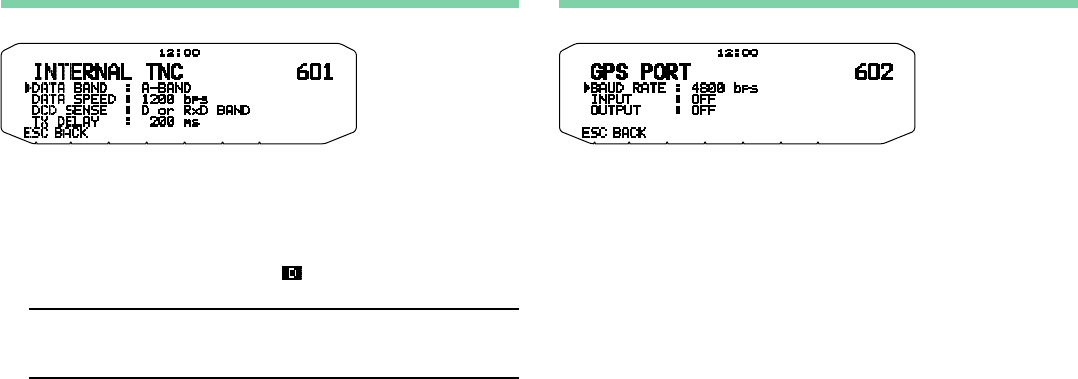
APRS-9
SETTING INTERNAL TNC
Enter Menu mode and access Menu 601.
■ Data Band <DATA BAND>
On this transceiver you can select data band for APRS mode
independent of the selection for Packet mode. Select band
A or B as the data band for receiving or transmitting APRS
packets. The default is band A. “
” indicates the current data
band.
Note: In Menu 601, the selection switches among A-BAND, B-BAND,
TX:A-BAND RX:B-BAND, and RX:A-BAND TX:B-BAND. Select TX:A-BAND
RX:B-BAND or RX:A-BAND TX:B-BAND if APRS networks which use two
separate frequencies become available in the future.
■ Packet Transfer Rate <DATA SPEED>
The default APRS packet transfer rate set on the built-in TNC
is 1200 bps which is the standard among the current APRS
networks. If APRS networks which use 9600 bps transfer rate
become available in the future, select “9600 bps”
■ DCD Sense <DCD SENSE>
You can also select the method for inhibiting the built-in TNC
from transmitting.
[D or RxD BAND]: When the data band is no longer busy (as
per the steps below), the packet is transmitted.
a Press [PTT] to enter transmit mode.
b The data band is busy.
[BOTH BAND]: When the bands are no longer busy (as per
the steps below), the packet is transmitted.
a Press [PTT] to enter transmit mode.
b The data band is busy.
c The other band is busy.
[IGNORE DCD]: Transmission from the built-in TNC is not
inhibited. The packet is transmitted immediately.
■ TX delay <TX DELAY>
This function allows you to set a transmission delay time
between transmitting the APRS data and transmitting a fl ag
code prior to the APRS data. When the other station has
activated their Save Mode, set a longer delay time.
SETTING GPS PORT
Enter Menu mode and access Menu 602
■ Baud Rate <BAUD RATE>
Set the communication speed of the external GPS or other
equipment that is connected to the GPS terminal. The speed
is set to 4800 bps (NMEA)/ 9600 bps (IPS format: SONY)
when a GPS receiver is connected.
• It does not correspond to the Gamin-TXT format.
■ Input Type <INPUT>
[OFF]: You can perform APRS communications without
the use of a GPS receiver or Weather Station. Set your
station position data manually through Menu No. 605 (MY
POSITION).
[GPS]: You can perform APRS communications using a GPS
receiver. Verify your station position data by pressing the
[POS] key.
[WEATHER (Davis)]: You can perform APRS
communications using a Davis Weather Station. Verify your
station weather data by pressing the [WXi] key.
• Operation verifi cation model (as of October 2013)
Vantage PRO2
TM
• Please use the Data Logger bundled with “WeatherLink
®
for Vantage Pro2
TM
, Windows, Serial Port” (Davis Part
No.06510SER) or “WeatherLink
®
for APRS, with Streaming Data
Logger” (Davis Part No.06540) with Vantage PRO2
TM
.
• When using the “WeatherLink
®
for APRS, with Streaming Data
Logger” (Davis Part No.06540) Data Logger, set the BAUD RATE
(Menu No.602) to 9600bps for stable operation.
[WEATHER (PeetBros. )]: You can perform APRS
communications using a PeetBros Weather Station. Verify
your station weather data by pressing the [WXi] key.
• Operation verifi cation model (as of October 2013)
ULTIMETER
®
2100 (Packet mode)
■ Output Type <OUTPUT>
[WAYPOINT]: Waypoint information is forwarded. The callsign
and positioning data received from another station can be
displayed as the waypoint data through the device connected
to your GPS receiver or on the GPS receiver display.
[DGPS]: Differential GPS information is forwarded. The
differential information which is received in the beacon from a
reference station (amateur radio station), is sent to the GPS
receiver.


















